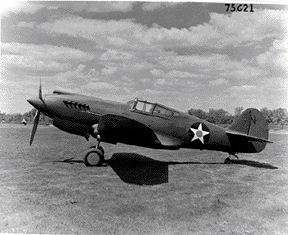Curtiss P-40 Warhawk and family
United States | Bell P-39 | Bell P-59 | Bell P-63 | Brewster F2A | P-36 Hawk | P-40 Warhawk | F4F Wildcat | F6F Hellcat | F7F Tigercat | F8F Bearcat | P-38 Lightning | Lockheed P-80 | P-51 Mustang | P-61 Black Widow | P-47 Thunderbolt | F4U Corsair
P-40 Warhawk and family
The P-40, seemingly advanced when America entered World War 2, was actually almost obsolete. Still, constant upgrades and new features made the P-40 the third most produced American fighter of the war. As you may tell from the shape of the tail section, the P-40 is essentially an inline-engined P-36. If you cover the front part of the aircraft picture below, letting the right hand side of the aircraft behind the leading edge of the wing, you will be hard pressed to tell the difference between a P-36 and P-40. The P-40 was a risky scheme, as at the time of its conception the air cooled radial engine was king and the Allison 12-cylinder Vee was new and novel, and nobody really knew how it would work. So the Allison was stuck onto a P-36 airframe and from that first primitive step evolved perhaps the single aircraft most essential to Allied victory.
There was trouble that the inline engine caused, but once these problems were settled the P-40B was placed into production, most being sent to Great Britain as the RAF Tomahawk I. In comparison with the Bf 109 or Spitfire, the P-40 performed badly except for its sturdy construction. Eventually, the RAF ceased using their P-40s as fighters and sent them to Africa as ground attack aircraft. These aircraft still had guns in the fuselage nose firing synchronized through the propeller blades, and around 1940 these were finally removed and replaced by the mighty six .50s - three in each wing.
American use of the P-40 was extensive. It first saw action in American hands as the aircraft of the well known Flying Tigers American Volunteer Group in China, who sported the famous 'shark mouth' on the noses of their P-40s. The shark mouth became the trademark for the Flying Tigers and the P-40 in general. A few P-40s got airborne in the attack on Pearl Harbor and one of them, flown my 2Lt George Welch, scored four kills, Welch himself ending the war with a total of 16.
A number of P-40s were fitted with Rolls-Royce Merlin engines, which at the time were the best inline engines available and far outclassed the Allison engines. These only saw action with the RAF, and none of these excellent machines ever flew for the USAAF.
The P-40 was produced through out the war years, its design continually improved until the final version, the P-40Q, which looked more like a P-51 Mustang than a P-36-derived Warhawk. But the same design core was old and obsolete, and the P-40Q was never put into production. Despite sheer numbers (almost 14,000 P-40s were built) and considerable press coverage, the P-40 has attained a reputation as a second-class fighter, one flown by as many heroes as victims, often a classic, but never a candidate for greatness.
Specifications for P-40N:
Type: Single Seat fighter
Powerplant: One 1,200hp Allison V-1750-88 liquid cooled inline engine 12-cylinder
Performance: Max speed 343mph; ceiling 31,000 feet.
Weights: empty 6,200lbs; loaded 8,800lbs
Armaments: six .50-calibre machine guns, three in each wings, and 1,500lbs of ordinance

P-40

P-40K Warhawk
More Information:
Remarks
10th P-36A w/ eng. chg.
Improved XP-40; 524 ordered
Designation not assigned
Imp. P-40; arm. pl.;2x.30-cal. mgs.
Imp. P-40B; self-sealing fuel tanks
Mod. fuselage; 4x.50-cal. mgs.
Imp. P-40D; 6x.50-cal. mgs.
P-40D w/ Rolls-Royce eng.
Mod. of 3rd P-40F built
Imp. P-40E; eng. chg.
Mod. of 66th P-40; -E wings
Designation not used
Imp. P-40E w/ turbo (canc.)
P-40K-10 w/ V-1650 eng.
Imp. P-40E w/ eng. chg.
Imp. P-40F
Imp. P-40K-20
Imp. P-40E; 4x.50-cal. mgs.
Imp. P-40N-1-15; eng. chg.
Last production P-40; 9,000 canc.
Designation not used
Mod. P-40N; 4-blade prop.
Mod. -F & -L models; eng. chg.
SPECIFICATIONS (P-40E)
Span: 37 ft. 4 in.
Length: 31 ft. 9 in.
Height: 12 ft. 4 in.
Weight: 9,100 lbs. loaded
Armament: Six .50-cal. machine guns; 700 lbs. of bombs externally.
Engine: Allison V-1710 of 1,150 hp.
Cost: $45,000
PERFORMANCE
Maximum speed: 362 mph.
Cruising speed: 235 mph.
Range: 850 miles
Service Ceiling: 30,000 ft.